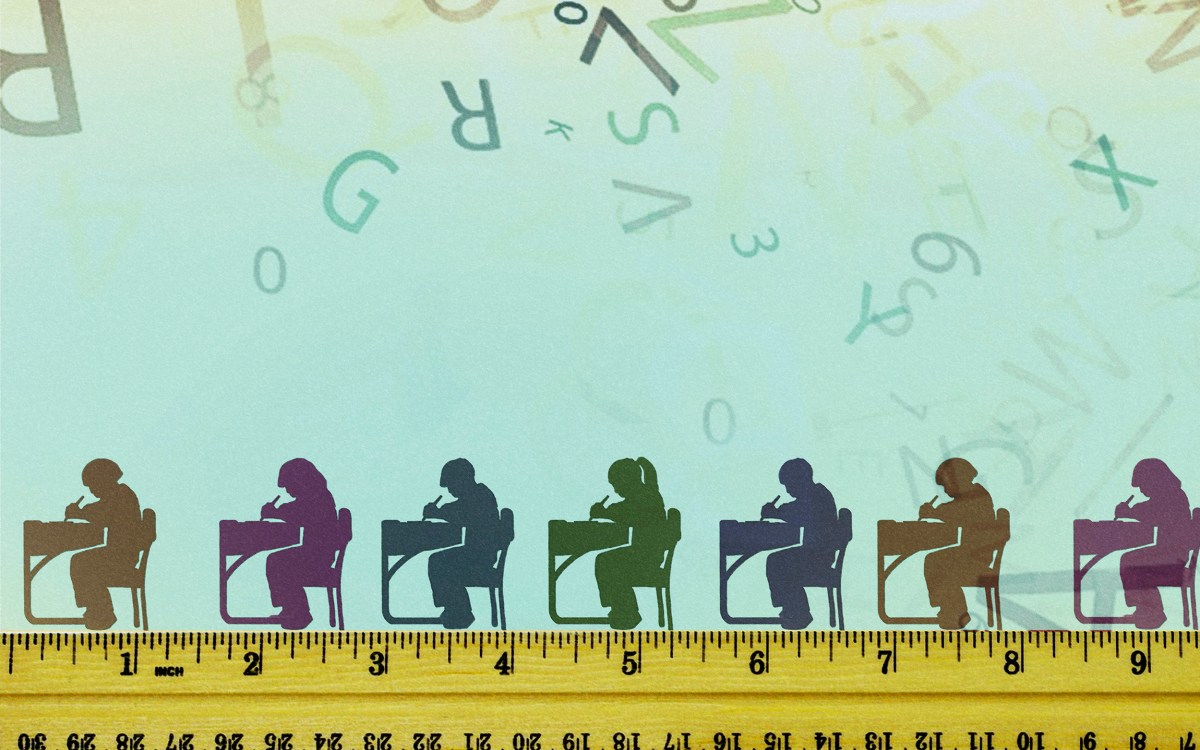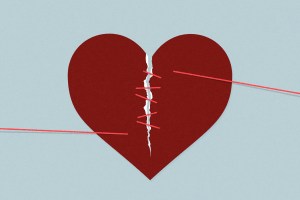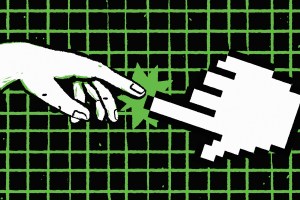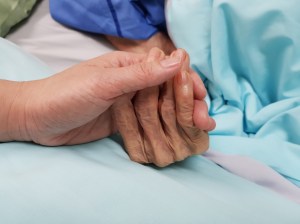
Illustration by Nick Lowndes/Ikon Images
What do we do with our loneliness?
‘Harvard Thinking’ examines health crisis with experts Jeremy Nobel and Milena Batanova
Current levels of loneliness in the U.S. are so high that the condition has been declared a public health crisis. The negative health outcomes are dire, elevating the risk of premature death to a rate comparable with regular smoking.
Loneliness itself “may be interpreted as the most human of feelings,” Jeremy Nobel notes in this episode of “Harvard Thinking.” Nobel is a faculty member at both the Harvard Chan School of Public Health and Harvard Medical School. He said that when people neglect or otherwise can’t meet their need for social connection, they can spiral into deep levels of loneliness that lead to serious health consequences.
“The spiral is what takes people to the excessive levels of loneliness,” Nobel says.
Milena Batanova, the director of research and evaluation at Making Caring Common in Harvard’s Graduate School of Education Research, shared that in a recent report her team found that nearly half of young adults felt like no one checked in on them in a way that showed they “genuinely cared.” This was related to loneliness, which is also found to be associated with anxiety and depression
“Those numbers are shocking to me,” said Batanova. “We’re seeing so many young people feel more lonely and like they don’t matter.”
In this episode, host Samantha Laine Perfas speaks with Nobel and Batanova about what’s driving our loneliness — and what we can do about it.
Transcript
JEREMY NOBEL: We’re all lonely from time to time. It’s just part of the human experience, just like we’re all thirsty from time to time.
SAMANTHA LAINE PERFAS: While it’s normal to feel lonely, people in the U.S. are experiencing loneliness at such high levels that Surgeon General Vivek Murthy declared it a public health crisis last year. Loneliness is more than a feeling; it hurts our minds and bodies and can lead to negative health outcomes comparable to smoking 15 cigarettes a day. So what can we do about it?
This is Harvard Thinking, a podcast where the life of the mind meets everyday life.
Today, I’m joined by:
MILENA BATANOVA: Milena Batanova. I have the pleasure of being the director of research and evaluation at Making Caring Common.
LAINE PERFAS: Which is housed in Harvard’s Graduate School of Education. And our second guest:
NOBEL: Jeremy Nobel, and I’m on the faculty at the Harvard Chan School of Public Health and also Harvard Medical School.
LAINE PERFAS: He’s also the author of a new book, “Project UnLonely: Healing Our Crisis of Disconnection.”
And I’m your host, Samantha Laine Perfas, and a writer for the Harvard Gazette. In this episode, we’ll discuss how we can break through our loneliness and connect with each other once more.
What do you mean when you are talking about loneliness?
NOBEL: I think there’s a lot of illiteracy around loneliness; loneliness is not the same as being alone. Really, it’s viewed as the difference between the social connections you would like to have, what some people dream about, and what they actually feel they experience. So it’s completely subjective. Being alone is an objective state, it can be measured as the absence of social connections, but it’s also important to know that being alone can be a state of such positive exploration of who you are, how you relate to the world around you. We have a high-class word for it. We sometimes call it solitude. And so it’s very important that we understand the difference and see them as social scenarios that we need to learn to navigate.
BATANOVA: I’d just add two things to that, I think it’s important to keep in mind that one can feel really deeply alone in a crowd or in a marriage or in a small clique of friends. So that’s to Jeremy’s point about how subjective it can feel, right? It’s not about the number of connections, but about the quality of connections that you feel you have. I agree with Brené Brown’s definition. She says ultimately loneliness is about belonging, whether or not you feel like you belong, not just with others, but also with yourself.
LAINE PERFAS: I was actually surprised to learn that there are different kinds of loneliness. Could you talk about those and how they show up in our lives?
NOBEL: For me personally, beginning to understand that there are different types of loneliness was incredibly helpful, both to understand the complexity, but then also as someone who works to design interventional programs. If you’re not clear what type of loneliness someone might be trying to navigate, then the programmatic support may be off-target. Here are the three types: First, psychological loneliness: “Where is someone I can confide in? Does someone have my back?” This is what most people think about when they think loneliness, and it’s certainly the way the media tends to portray it. It’s also the way we’ve studied it. Second is societal loneliness. “Am I feeling systematically excluded because of some characteristic, whether it’s because of gender, race, disability, simply not conforming to the conventional beauty myth of the moment?” And the third is existential or spiritual loneliness. “Do I feel I connect to the bigger narrative of human experience? Does my life have meaning, purpose?” This type of loneliness has probably been around for thousands of years. It’s the basis of much spiritual and religious work. This is a very different type of loneliness than “I don’t have a friend” and very different type of loneliness than “I’m systematically excluded.” And I think you can have all three of these types of loneliness or none of them, but it’s clear that if you want to be less lonely, it’s useful to start with asking “What kind of loneliness do I have?”
BATANOVA: That’s really interesting. I like how you break it down. I knew about the types of loneliness as intimate, relational, and collective, so they map on similarly. In our research, it’s really concerning that young people in particular, we found really recently, the majority of young adults said that they don’t feel a sense of meaning or purpose in their lives. And this was really strongly correlated to anxiety and depression. But we were really shocked at just the number, right? How many felt they lacked that? And to your point, it’s existed through the years, but we’re concerned that it’s now really accelerated, and that it’s much harder for people to find meaning, and it is also really related to everyday connections or feeling like people don’t matter. Something like 44 percent of young adults told us they don’t feel like they matter to others. Those numbers are shocking to me and point to how dangerously interconnected these types of loneliness are.
NOBEL: I completely agree. I think this may be the riskiest time for loneliness that we’ve ever experienced. Now, because of certain structures in society, the internet is the obvious one that comes up, the ability to engage with people or lack of engagement that immediately impacts your sense of self and with that self-esteem and with that confidence and with that change in behavior, then the ability to spiral out of control in loneliness is what we should be most concerned about. Loneliness may be interpreted as the most human of feelings. We’re all lonely from time to time. The challenge is that when that little bit of loneliness can’t get satisfied in the same way we satisfy thirst by getting some hydration, then the risk is you and your brain become a little lonelier and you’re a little more avoidant, a little less self-confident, a little less willing to take the risk of putting something authentic about yourself out there so you could be seen and recognized. And so as a result, you become a little lonelier. And as a consequence, a little more avoidant and a little less tolerant. And so this is a spiral. And I think it’s important to know that the spiral is what takes people to the excessive levels of loneliness, like loneliness will increase risk of early death like smoking 15 cigarettes a day. The interesting question is, can we actually come up with a set of interventions, responses, both personally and socially, that we can turn that spiral in the other direction?
LAINE PERFAS: Are there certain demographics that are more prone to experiencing that deeper level of loneliness?
NOBEL: There are actually zones, call them zones of social activity, where we know there’s a high risk for spiraling, and I identify five of them in my book. I call these territories of loneliness. The first one is trauma itself; the traumatized brain leads to a traumatized mind leads to traumatized behaviors, all of which are about avoidance and increased risk for disconnection. The second is illness; whether it’s catastrophic illness with risk of dying, serious, chronic illness, or even a rare illness, it changes your understanding of yourself and how you relate to other people. Illness can be quite a lonely experience. Third, aging; as you grow older, I’m in that demographic now, you start losing friends, you start losing your own faculties, whether it’s hearing acuity, visual acuity, all at risk for being further challenged in connection. The fourth is difference; whether it’s gender, race, disability, and so on, we know that those differences often marginalize people in ways that make them much more susceptible to loneliness. And the fifth territory is what we’re all living through, modernity, the modern world; increased political divisiveness, social media use primarily for the basis of comparison and performance, is quite marginalizing. These are all marginalizing factors and people can be in many of these territories, not just one.
BATANOVA: One thing I did read and Jeremy, of course, correct me if I’m totally wrong on this, was that while aging can be a risk, older adults, especially much older, do better than younger and one of the main explanations I found for this was that older adults are more secure in their relationships. They have more stable or intimate social connections and networks, and they just know how to navigate conflict and other things that might arise in relationships that younger people are still learning.
NOBEL: It’s absolutely true, you know, that the older part of the older adults often are least lonely. But you also, as an epidemiologist, I do need to point out we know that loneliness increases risk of early death by 30 percent. The lonely people die. The people who are still alive into old age are the ones who’ve had positive health behaviors that include social connection. That’s part of what’s enabled them to have longer lives, and some of that’s because of the physical benefits of being connected. We know that it improves immune function, it reduces blood pressure, and so on. So if you are less lonely, you are more likely to live into older age. You start filtering out of that population the groups who are severely lonely. It also, loneliness increases risk of heart attack or stroke or death from either by 30 percent, dementia by 40 percent, diabetes by 50 percent. So part of what we may be seeing isn’t that the oldest adults suddenly transform into being more connected. It’s the ones maybe who were more connected, who lived to be older adults.
LAINE PERFAS: What do you think is driving the kind of loneliness that leads to social disconnection? One thing I was thinking about was the role of vulnerability. Are we afraid to admit that we’re lonely?
BATANOVA: Interestingly, we did a brief report on loneliness a few years back. Actually, it was right during the pandemic, where we did another survey and we found that a lot of the adults and young adults who reported being lonely also reported being vulnerable, which was interesting, right? Because it did squash that myth that maybe there’s a lack of vulnerability. They reported more vulnerability and they reported that they actually felt like they reach out to people more than people reach out to them. Or that they’re better listeners than people listen to them, or that they try to understand other people’s perspectives more than others try to understand them. But clearly there is that perception gap, right? The perceived empathy gap, this idea that you feel like people are just not empathizing or connecting with you the way you are connecting to them or that you think you’re connecting to them. I don’t necessarily think it’s an issue of lacking vulnerability or lacking empathy. It’s certainly an issue of expectations. Maybe we are expecting a little too much from our relationship sometimes, especially when we live at a time that is just so busy. And I think it can get really frustrating when someone doesn’t respond to you right away, and I can certainly see how that spiral can turn on itself. So it’s very much about like finding balance, seeking balance, about the need to give people strategies and tools to cope with negative thoughts and truly negative experiences so that they can interact in healthy ways.
NOBEL: It’s also important to point out that there’s pretty good research that shows the lonely brain itself starts reinterpreting ambiguous signals as negative ones. Here’s an example. You’re walking down the street. Someone’s walking toward you. It’s a city you don’t know very well. The sun’s just gone down. Is the person you’re seeing a social opportunity or a social threat? We’re not conscious of this, but our brains are asking that question all the time, because it’s one of the big jobs of our brain to help us to survive by anticipating all kinds of threats. And so it’s been well-studied that as brains get “lonelier and lonelier” — I put quotations around that because there are a lot of parameters there, ambiguous signals, right? Just somebody walking toward you on a street, increasing likelihood that your brain will interpret that as a threat and react in a way that you’re going to be a little more reserved, hold back, maybe even change your social signals. So you’re interpreted as being avoidant, if not hostile. And then the other person, remember, they’re neutral, starts seeing you begin to change and looking a little more avoidant and maybe even hostile. And they say, whoa, there’s an avoidant hostile person and then it starts triggering them. So this is a sense of almost a dyadic spiral where people working together start increasing their sense of risk, concern, and threat. And become increasingly disconnected. The interesting thing, and obviously the big hope here is you could also have that spiral go the other way; be kind, anticipate someone’s need, try to be thoughtful, compassionate. And then they say, “Oh, here’s someone trying to be connected. So maybe I don’t have to be quite as fearful. I don’t have to be quite as reserved. I could tolerate the discomfort of sharing something authentic about myself. Why don’t I try doing that?” That’s really at the heart of what I think we can begin to embrace as not an experiment or an intervention, but a culture of connections.
LAINE PERFAS: Do you think given that so many people are experiencing loneliness right now that tendency to interpret ambiguous signals as more threatening is feeding into what we’re seeing in our political discourse or what we’re seeing a lot in our culture right now?
NOBEL: There’s no question at all that’s what’s going on, and a really tragic, but a perfect example of this goes by the name of wrong-address shootings. Someone innocently shows up on a porch, the wrong address, rings the doorbell, and gets shot through the screen door. These are going up, and even having someone fire on your car as you’re departing on the driveway after having pulled into the wrong address. So this happens. If you start again asking, what else does the lonely brain do? The lonely brain becomes much more impulsive. It has a reduced threshold to action. It over-interprets negative threat and it becomes very emotion-based in its decision-making, rather than rational. This is now starting to spiral, not just in our social interactions, but into the political world. Our lack of tolerance for open conversations where we could have legitimate disagreement on things now is being increasingly viewed as threatening or risky. The result? People are withdrawing even further and we’re losing the ability to have civil conversation, which is the basis of democracy.
BATANOVA: I don’t think we can have a conversation about loneliness without having a conversation about polarization, and dehumanization for that matter. There are a lot of great people and organizations out there doing bridging work. It’s like a new field to bridge differences, and I think that field has such promise and potential to mitigate loneliness.
NOBEL: One thing I wanted to ask about as well, as we talk about living in the modern world and some of the unique challenges we face, is the presence of technology in ways that were never part of the equation 50-100 years ago. How does technology fit into this conversation? Are there aspects of technology that could bring us together or is technology keeping us apart?
Yes. It’s all of those things.
LAINE PERFAS: Thank you. End of conversation.
NOBEL: Technology has always been somewhat neutral. Let’s take a technology, we all know karaoke, right? That could give you a wonderful evening or a terrible evening. It’s just technology.
But seriously, the technologies are quite powerful in restructuring how we connect with other people as well as how we connect with ourselves. Toxic use of social media by certain demographics, Milena, I’d love your view on this, but I think that’s a significant part of the crisis for teenagers and young adults.
BATANOVA: The social media research is really interesting, right? I find it interesting that there’s a lot of talk about how it can be productive and constructive and even moderate use can be beneficial for young people. And while that is true, we also know that online interactions tend to mirror offline interactions. People who are very social and in person can also be very social online. But what about the people who are not doing well? There’s many people for whom we know social media can be debilitating and so to me, just on a very, like, personal, less academic standpoint, it’s concerning that social media can have such damaging effects for people. If we know that, we should be concerned. And technology more generally, it’s just a distraction, right? It’s constantly there. It’s constantly at our fingertips. There are even studies to show that having your phone on a table will lessen or worsen the type of interaction that you have with the person you’re sitting with on that table.
A friend of mine actually, we were just talking about this. He was wondering why a friend of his constantly asked to go golfing, and yet when they’re at the golf course, his friend who’s the one inviting and asking to go is always on his phone, always. He’s playing games on his phone in the golf cart. My friend who is telling me this is, “I just don’t get it. Why even ask me to go? Why doesn’t he just go on his own?” And so the friend telling me this, he’s not the lonely one in this scenario. I really wonder if the friend on the phone is. What is going on that he feels the need to lose himself in his phone when he’s doing an activity he loves with a friend that I’m sure he also loves? That’s a great example of how technology can really get in the way and disconnect us from having like truly meaningful, engaging time together.
NOBEL: There’s phone as distraction for sure, but I also think that the body of evidence now has become pretty significant that social media use, particularly in the demographic we’re talking about, has an undeniable toxic effect. This was published out of the University of Pennsylvania, 2019, just before the pandemic and this was college students they recruited, putting a 60 day, just-social-media diet — they didn’t even eliminate it, they just limited it to an hour a day of social media use — had statistically significant improvements in anxiety and depression symptomatology. We know there’s something about this that’s different than phone use, the social media use per se.
BATANOVA: And to that point, I love that even Vivek Murthy, you know, our surgeon general, I love how much he actually talks about this. He’s really trying to push for more regulation and safety when it comes to social media in particular. He really wants them to take a safety-first approach, just like we do with other public health initiatives, like wearing seatbelts. I do think we need to be talking more about that and holding these major platforms and corporations accountable. Because we do know how damaging it is for young people, despite so much research also showing benefits.
LAINE PERFAS: Does technology itself lead to different levels of connection? For example, what’s the difference between having a 15-minute conversation with someone in person versus a 15-minute conversation via text?
BATANOVA: I think so much can get lost in texting, especially. Things can be read the wrong way. Emojis can only go so far. Again, going back to those spirals we were talking about, the in-person interactions are probably going to give us more of that meaning, of that real heart that we desire. And we do see some of that in our research. We asked our young people how they prefer to get support, when they might be struggling with something, and unequivocally, the majority said in person. Much fewer said through texting or even FaceTiming or video conferencing. Even Vivek Murthy writes that in his loneliness report. There was lots of research he overviewed on just the astronomical decline of in-person interactions and in-person time together in general, especially among young people. And at the same time we’re seeing so many young people feel more lonely and like they don’t matter. Might not be such a coincidence, right? I think those trends point to something. We really need to revisit that physical time together.
LAINE PERFAS: What are things that we can do if we are suffering from loneliness? How do we find our way out of it? What advice do you have for people?
NOBEL: One of the most important things is, first of all, to know that if you’re lonely, it’s not your fault. It’s a combination of social and cultural phenomena that you are navigating that for many people think it is their fault and leaves them with the shame, low self-esteem, sense of guilt that actually traumatizes them and reduces the likelihood that they will take the risk of connection to others. So be kind and self-accepting that as humans, we’re all lonely from time to time. It’s just part of the human experience, just like we’re all thirsty from time to time.
But then also educate yourself and have conversations about the importance of connecting and take the risk, which always feels like, “Oh, if I share something important about myself, I may be critiqued. I may be marginalized because people don’t like what I say.” But, just like we take risks in other aspects of our lives in order to learn, in order to explore, take those risks. You’re not alone. Over half the people around you are also navigating loneliness. And if we can break through to have the conversations about it, and I do think one of the most powerful things about the arts is they give us not only the inspiration to tell our stories, but the means. To tell our story through visual art, through photography, through poetry, through music, through cooking, culinary arts, even through gardening, we can actually find that we have common ground, that we can see each other for who they are. We can allow ourselves to be seen for who we are and have the human connection that’s increasingly clear is essential to being healthy and well.
BATANOVA: I think it’s really important to know who to reach out to, when. What would reinforce a lot of those spirals is reaching out to someone who might actually make you feel worse, right? So not every connection is necessarily a great connection. It’s really important to be more socially attuned, socially wise that way. And do good. There is so much great research out there showing that intentional acts of kindness and goodness are so beneficial for us. And I say intentional because sometimes altruism and just the continual charity can have watered-down effects. It starts to feel like any other day, the norm. So I think just being more thoughtful about what you do, how you do it, who you do it for, could be really beneficial and that’s all individual level. Socially we need more policies, strategies, programs that really put connection front and center. We need really creative, fun solutions. No one’s talking about fun. Can we just have some really cool, fun, innovative ways to connect? We can do so much, right? If we really just put our heads together and keep it simple. I don’t think it has to be hard. I don’t think it has to be something groundbreaking, but it does have to be something intentional and fun.
LAINE PERFAS: Thank you guys for this wonderful conversation.
BATANOVA: Yeah, absolutely. Thank you for having us.
NOBEL: Thanks, Sam, for organizing this and giving us a chance to connect.
LAINE PERFAS: Thanks for listening! To find our other episodes and a transcript of this one, visit harvard.edu/thinking. This episode was hosted and produced by me, Samantha Laine Perfas, with editing by Ryan Mulcahy, Simona Covel, and Paul Makishima, additional production support by Christy DeSmith and Anna Lamb. Original music and sound designed by Noel Flatt. Produced by Harvard University.
Recommended reading/listening:
- Project UnLonely: Healing Our Crisis of Disconnection by Jeremy Nobel
- Advisory Raises Alarm about the Devastating Impact of the Epidemic of Loneliness and Isolation in the United States, Surgeon General Dr. Vivek Murthy
- Dr. Vivek Murthy and Brené Brown on Loneliness and Connection from “Unlocking Us”
- “In a Nation Armed to the Teeth, Thse Tiny Missteps Led to Tragedy” by The New York Times
- “Loneliness in America: How the Pandemic Has Deepened an Epidemic of Loneliness and What We Can Do About It,” a report from Making Caring Common













